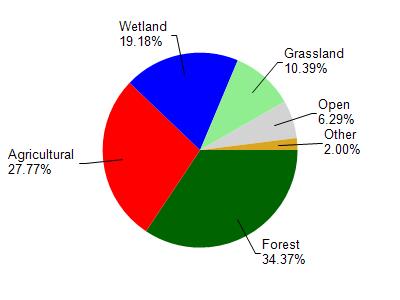Waushara
No
No
No
Fish and Aquatic Life
Overview
Brownlow Mud Lake, in the Pine and Willow Rivers Watershed, is a 9.06 acre lake that falls in Waushara County. This lake is managed for fishing and swimming and is currently not considered impaired.
Date 2011
Author Aquatic Biologist
Historical Description
A small, wilderness lake deriving its water source from springs and seepage. The lake is moderately fertile and exhibits clear water. Stratification occurs with development of the upper thermocline at a depth of 10 feet during midsummer. The littoral zone of the lake basin is very small because of abrupt drop-offs close to shore. Bottom materials in this zone consist of muck and marl. Winterkill has not been reported in the lake. The outlet of the lake forms the headwaters of Little Silver Creek, a trout stream tributary to the Pine River. The major fishery of the lake includes northern pike, largemouth bass, bluegills, black crappie, green sunfish and perch.
Evidence of a slow-growing panfish population has been reported and will be an important consideration in the future management of these waters. There are 28 acres of adjoining wetlands which contribute to the game assets of the lake area by providing nesting habitat for bluewing teal and wood ducks. Public access is not available. Source: 1970, Surface Water Resources of Waushara County Brownlow (Mud) Lake T-19-N, R-11-E, Section 12 Surface Acres = 9.6; S.D.F. = 1.38; Maximum Depth 21 feet
Date 1970
Author Surface Water Inventory Of Wisconsin
Condition
Wisconsin has over 84,000 miles of streams, 15,000 lakes and milllions of acres of wetlands. Assessing the condition of this vast amount of water is challenging. The state's water monitoring program uses a media-based, cross-program approach to analyze water condition. An updated monitoring strategy (2015-2020) is now available. Compliance with Clean Water Act fishable, swimmable standards are located in the Executive Summary of Water Condition in 2018. See also the 'monitoring and projects' tab.
Reports
Management Goals
Wisconsin's Water Quality Standards provide qualitative and quantitative goals for waters that are protective of Fishable, Swimmable conditions [Learn more]. Waters that do not meet water quality standards are considered impaired and restoration actions are planned and carried out until the water is once again fishable and swimmable
Management goals can include creation or implementation of a Total Maximum Daily Load analysis, a Nine Key Element Plan, or other restoration work, education and outreach and more. If specific recommendations exist for this water, they will be displayed below online.
Monitoring
Monitoring the condition of a river, stream, or lake includes gathering physical, chemical, biological, and habitat data. Comprehensive studies often gather all these parameters in great detail, while lighter assessment events will involve sampling physical, chemical and biological data such as macroinvertebrates. Aquatic macroinvertebrates and fish communities integrate watershed or catchment condition, providing great insight into overall ecosystem health. Chemical and habitat parameters tell researchers more about human induced problems including contaminated runoff, point source dischargers, or habitat issues that foster or limit the potential of aquatic communities to thrive in a given area. Wisconsin's Water Monitoring Strategy was recenty updated.
Grants and Management Projects
| Project Name (Click for Details) | Year Started |
|---|
|
|
Monitoring Projects
| WBIC | Official Waterbody Name | Station ID | Station Name | Earliest Fieldwork Date | Latest Fieldwork Date | View Station | View Data |
|---|
| 248700 | Brownlow Lake | 10007461 | Brownlow Lake | 7/27/1999 | 9/22/2017 | Map | Data |
|

Watershed Characteristics
Brownlow Lake is located in the Pine and Willow Rivers watershed which is 302.08 mi². Land use in the watershed is primarily forest (34.40%), agricultural (27.80%) and a mix of wetland (19.20%) and other uses (18.70%). This watershed has 377.48 stream miles, 11,273.01 lake acres and 33,136.61 wetland acres.
Nonpoint Source Characteristics
This watershed is ranked High for runoff impacts on streams, Not Ranked for runoff impacts on lakes and High for runoff impacts on groundwater and therefore has an overall rank of High. This value can be used in ranking the watershed or individual waterbodies for grant funding under state and county programs.However, all waters are affected by diffuse pollutant sources regardless of initial water quality. Applications for specific runoff projects under state or county grant programs may be pursued. For more information, go to surface water program grants.